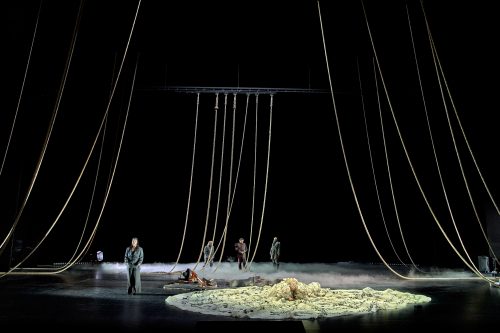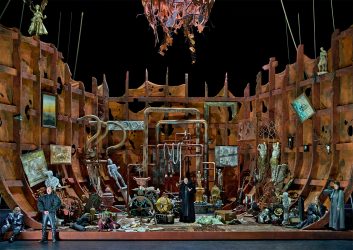
 Germany Bayreuth Festival 2024 [3] – Wagner, Tristan und Isolde: Soloists, Bayreuth Festival Chorus and Orchestra / Semyon Bychkov (conductor). Festspielhaus, Bayreuth, 3.8.2024. (MB)
Germany Bayreuth Festival 2024 [3] – Wagner, Tristan und Isolde: Soloists, Bayreuth Festival Chorus and Orchestra / Semyon Bychkov (conductor). Festspielhaus, Bayreuth, 3.8.2024. (MB)

Production:
Director – Thorliefur Örn Arnarsson
Set design – Vytautas Narbutas
Costumes – Sibylle Wallum
Dramaturgy – Andri Hardmeier
Lighting – Sascha Zauner
Chorus director – Eberhard Friedrich
Cast:
Tristan – Andreas Schager
King Marke – Günther Groissböck
Isolde – Camilla Nylund
Kurwenal – Olafur Sigurdarson
Melot – Birger Radde
Brangäne – Christa Mayer
Shepherd – Daniel Jenz
Steersman – Lawson Anderson
Young Sailor – Matthew Newlin
Almost uniquely amongst operas (dramas, if we prefer), Tristan und Isolde resists conceptualisation, even much in the way of framing. Perhaps not uniquely, but to a greater extent than any other. Any attempt to make Tristan ‘about’ anything other than what it is intrinsically about seems doomed to fail. I continue to live in dread of the director who decides it is somehow ‘about’ immigration, Covid, or anything pertaining to the phenomenal world. So many, distrusting or simply uninterested in music, seem incapable of sensing what it is concerned with.
Put frankly, if you are uninterested in music, you should leave Tristan well alone. Its action is interior; the exterior is largely back story. For Wagner at his most Schopenhauerian, in aesthetics as much as ontology, the striving of the Will is the action, to which music – not opposed to, but as drama – as its representation comes closer than any other art form or means of expression. It is the music drama in which least would be lost if words and staging were discarded. In reality, of whatever kind, that how we listen to it, even when convinced otherwise. At a certain point in the Act II love duet, it becomes difficult, even impossible, to have the words, fascinating, complex, and telling though they may be, register in one’s consciousness. Whether we call this the world of the noumenon, of night, of Dionysus, or of Tristan, we as well as the lovers are – or should be – there and not in its phenomenal, diurnal, Apollonian, operatic equivalent.
All very well, you may say, but we do have words, we do have singers, we do have staging. Indeed we do, and they – singers and staging, in a sense words too – must work within these realities, these artistic truths. That need not be a problem; art thrives upon constraint of one sort or another. (Ask Wagner’s antipode, Stravinsky.) Too often, though, directors do not, perhaps cannot, since they seem to have little sense of what this work is actually concerned with, still less that it seemingly cannot be wrenched to be concerned with anything else. A signal feature of Bayreuth’s new Tristan, which I saw in its second performance, is that Thorliefur Örn Arnarsson seems to grasp this, in theory and in practice, and moreover to grasp that this does not negate but rather invites his work as director. There are cases, I think, in which he might go further in this direction in paring down the extraneous – is there a better model than Wieland Wagner here? – but this makes for a very good start and, following so many misfires, whether in Bayreuth or elsewhere, comes as a great relief.
Nietzsche wrote a good deal of arrant nonsense about Wagner, often deliberately so, yet in calling Tristan the opus metaphysicum, he was on the mark. Only a couple of stagings I have seen, by Dmitri Tcherniakov (review here) and Peter Konwitschny in Munich, have offered serious challenge to that and Konwitschny in considerably more circumscribed fashion; they are destined, I suspect, to remain exceptions. Anarsson’s production treads on safer ground, neither without reason nor without advantage Moreover, there is to Anarsson’s work and to that of his collaborators, not least the outstanding Semyon Bychkov as conductor, a sense not only of the noumenal but of the aesthetic.
Ship enthusiasts will find themselves well catered for. Not only the first act but the entire drama has a ship as its setting. Vytautas Narbutas’s set designs evoke this powerfully, suggestively, and without clutter — save, in the second act, where the clutter is the point. Ropes mostly do the trick in the first act, whose abiding visual motif is Isolde’s billowing wedding dress, also suggestive of sails. The words displayed – and just as much, concealed – on it from Wagner’s poem tell their own story, especially as she attempts, with varying success and perhaps intent, to free herself from it. Anarsson sees no reason actually to visualise the love potion, knowing that it is simply a symbol, not a cause. I have no especially strong feelings either way on that in principle; it is merely an external manifestation. It felt slightly odd, though – I realise this may seem somewhat at odds with what I say above – as did the onset of what seemed like a realistic fight between Tristan and Melot at the end of the second act, Melot wielding a sword, only for its outcome to happen seemingly spontaneously. Those objects and acts of the day perhaps benefit, if less strongly than their counterparts in the Ring, from some sort of visualisation.

The second act moves to the inside of the ship, seemingly its core: the core, one might say, of what action there may be. Its décor is fascinating, suggesting a lumber room strewn with objects that may in some sense have led us – which is to say Wagner, the work, those performing and otherwise experiencing it – there. Caspar David Friedrich’s presence is doubtless inevitable, and will at least evoke recognition, though part of me feels it is time to give his more celebrated images, like those of Monet and Klimt a while ago, a period of rest. The broader, unaggressive deconstruction of ‘civilisation’, western and perhaps eastern too, forms a captivating backdrop for the stage and ultimately the ‘real’ action. Cleared of that baggage, moved to a different part of (presumably) the same ship, the third act unfolds in a ‘later’, barer environment. It already feels too late, which in the most obvious if not necessarily the deepest sense, it is. Lighting, or rather its lack, throughout seems intended both to accentuate but also to develop the contrast between night and day. It reminds us that these are not operatic characters; the point is not necessarily to observe them minutely. There are greater forces – ultimately, one great, overwhelming force – at work.
Following the crude lack of direction, balance, and tuning brought to us two nights earlier by Oksana Lyniv in the covered pit, Bychkov’s work sounded like aural manna from heaven. He knew how to work with the theatre and its particular characteristics; beyond that, he knew the workings and expressive possibilities of Wagner’s score and communicated them in a reading that often took its time, especially in the second act, yet never dragged. The opening of the first-act Prelude – and its echo, towards the end of the act – sounded more beautifully hushed than I can recall, yet in no sense narcissistically; this was expectant, apparently imbued with knowledge, albeit knowledge that could not yet be imparted, of where the music would head, of what dramatically, in the fullest sense of the world, was at stake in melody, dissonance, and their consequences, always, if sometimes only just, within a tonal framework. That was the story, in which intensification of string vibrato could play as important a role as overwhelming orchestral climax. Bychkov did not hold back; his is not Wagner that defers to the voice, nor to anything other than its own musicodramatic requirements. He nonetheless helped liberate the voice’s expressive potential, even when vocal realities fell short of the ideal.
I did not feel that so strongly as a couple of people I have spoken to since and wonder how much of that might be ascribed to seating in the theatre (as well, perhaps, as to aesthetic priorities). Seated at the back of the stalls, I may have benefited from the healing balm of the Bayreuth acoustic. That said, Andreas Schager’s Tristan, for stretches of the performance possessed of many of this Heldentenor’s familiar qualities, also experienced difficulties. Balance in the second-act duet was sometimes awry with Camilla Nylund’s Isolde, who at times also seemed stretched, if more in control of her part. A degree of abandon is, of course, no bad thing; Schager’s performance, however, came into and went out of focus a little too often and became strangely disjunct in the third act, as if the effort to sing more softly, to offer a more variegated reading, made it more difficult to maintain his line at all.
Christa Mayer’s Brangäne was, by contrast, everything it should have been: warm, sustained, intelligent, and as well as integrated as any orchestral line. Günther Groissböck’s snarling Marke seemed to be making a play to come across as more cruel, even vindictive, than one might expect; this emerged as something of a work-in-progress. If a little bluff, even gruff at times, Olafur Sigurdarson had what it took for Kurwenal. The smaller roles were all well taken, Birger Radde’s ambivalent Melot, Daniel Lenz’s sweetly sung Shepherd, and Matthew Newlin’s clear-toned Sailor all standing out, whilst taking their place in the greater ensemble. The latter was ultimately what mattered and which, shortcomings aside, made this a satisfying and often moving whole.
Mark Berry